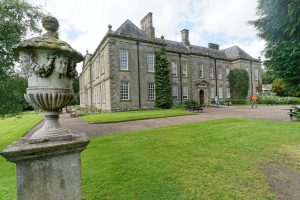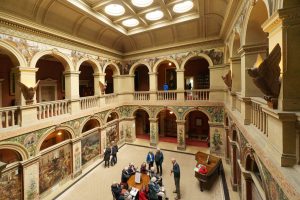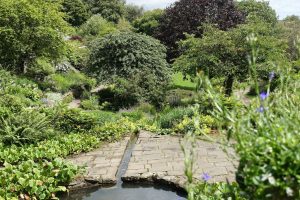On arrival, after a good, trouble free journey to Wallington Hall, annoyingly the rain arrived too and periods of heavy rain and then sunshine became the pattern of the day. However, it did not spoil our enjoyment.
The house is set in 10 acres of parkland, part of a 13,500-acre estate, including wooded valleys, ornamental lakes, lawns and a walled garden.
The House
The Blacketts bought Wallingford in 1689 from the Fenwicks, as a country retreat from their home in Newcastle. They were a wealthy family gaining their money from Lead and Coal mining. Ten generations of Blacketts and then Trevelyan families went on to live here. William Blackett knocked down the Pele tower and converted the ground floor into Cellars, and rebuilt the house around the courtyard.

The new house was very basic, used only for the occasional shooting party. Upon the death of Sir William’s younger son, who left high debts and an illegitimate daughter Elizabeth, Wallington passed to nephew Walter Calverley on condition that Walter married Elizabeth and adopt the family name Blackett.
This marriage, from 1728, worked well and they had the interior of the house remodelled and recreated the clock tower which still dominates the court yard. The gardens and the estate were re-designed with the help of many, including a local lad – Capability Brown.
Pietro Lafranchini created the stunning Rococo plaster-work ceilings:
All Sir Walter’s children died before him so Wallington passed to his sister’s son, Sir John Trevelyan. The estate stayed in their family until 1941 and then was gifted to the National Trust by Sir Charles Trevelyan, the socialist MP and ‘illogical Englishman’.
 The central living hall has a coved ceiling, a balustrade, and walls painted with flowers and scenes from Northumbrian history, by William Bell, Lady Trevelyan and John Ruskin. Throughout the house there is a spectacular display of Japanese, Chinese and Meissen China – the largest NT collection in Britain.
The central living hall has a coved ceiling, a balustrade, and walls painted with flowers and scenes from Northumbrian history, by William Bell, Lady Trevelyan and John Ruskin. Throughout the house there is a spectacular display of Japanese, Chinese and Meissen China – the largest NT collection in Britain.
Not to be missed are the collection of dolls’ houses – the Hammond Dolls House is an amazing model of exquisite craftmanship, all original. Found in the same room, the collection of minute model soldiers is something to behold. The four sons of Sir George purchased the soldiers with their pocket money from the Burlington Arcade in London.
The Walled Garden
The walled garden at Wallington is, unusually, a half mile walk from the house through East Wood and past a lake with water lilies. The unassuming entrance is through a small gateway and you enter into a completely different world. The hidden garden is in a dell and so creating planting on different levels. On entering, there is a sunken garden of stone walls with curved steps down to a water garden pool, a little sanctuary with seating for quiet contemplation.

It was Sir George Trevelyan who inherited Wallington in 1886 and developed most of the garden we see today. He created opulent herbaceous borders bringing urns and statues from Italy for the terraces of the garden.
The garden is like no other walled garden I have seen. There is not a vegetable in sight. They were removed in the 1960s and 70s by the National Trust Garden adviser, Graham Stuart Thomas, who introduced a Gertrude Jekyll style of garden. There are beautiful old walls cascading with plants and many interesting paths waiting to be explored, if there had been more time.
Thank you to Geoff for all the arrangements; a very enjoyable day. Also, to Sean our driver for his impeccable driving.
